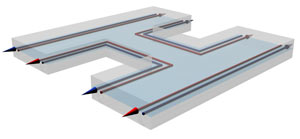
Handy Links
SLAC News Center
SLAC Today
- Subscribe
- Archives: Feb 2006-May 20, 2011
- Archives: May 23, 2011 and later
- Submit Feedback or Story Ideas
- About SLAC Today
SLAC News
Lab News
- Interactions
- Lightsources.org
- ILC NewsLine
- Int'l Science Grid This Week
- Fermilab Today
- Berkeley Lab News
- @brookhaven TODAY
- DOE Pulse
- CERN Courier
- DESY inForm
- US / LHC
SLAC Links
- Emergency
- Safety
- Policy Repository
- Site Entry Form

- Site Maps
- M & O Review
- Computing Status & Calendar
- SLAC Colloquium
- SLACspeak
- SLACspace
- SLAC Logo
- Café Menu
- Flea Market
- Web E-mail
- Marguerite Shuttle
- Discount Commuter Passes
-
Award Reporting Form
- SPIRES
- SciDoc
- Activity Groups
- Library
Stanford
Around the Bay
A New Path of Conduction for Future Electronics
Last month, researchers from SLAC National Accelerator Laboratory and Stanford University made headlines when they revealed experimental evidence of a topological insulator: a material that could revolutionize computer processors by allowing electricity to flow without resistance. This week in Science, the theorists along with an experimental group in Germany report additional details about the way these topological insulators conduct electricity. Using the topological insulator mercury telluride, the paper shows that an electric current sent through these materials goes against conventional physics knowledge and travels far away from its input points, to the outer edges of the material.
"This is another manifestation of this new state of matter, which is totally different than anything we're familiar with," said co-author Shou-Cheng Zhang of the Stanford Institute for Materials and Energy Science, a joint Stanford/SLAC institute. The current generation of microprocessors dissipate a lot of energy as heat, Zhang said, as result of electrical resistance. "It's one of the greatest obstacles facing the information age today. The current experiment proves that there is a possible motion of the electrons that does not dissipate energy in the traditional way."
Imagine moving through a crowded ballroom trying to make your way from one end to the other while dancing couples fill the space. You keep bumping into other dancers, losing your energy and your patience along the way. Similarly, as electric currents pass through conductors, they bump into other electrons and lose their energy. But in topological insulators the electrons exhibit a spin-orbit coupling, as if they were traveling and spinning smoothly in the same direction as all the other dancers, preventing collisions and loss of energy. Last month Zhang and colleagues demonstrated this behavior in bismuth telluride. The new results show that the electrons also take a unique path through the "ballroom." They move around the edge of the topological insulator, even if that means moving far away from the input and output points of the current. In contrast, the current in a regular conductor will take the shortest route possible between those two points.
Zhang and SLAC physicists and Xiao-Liang Qi and Joseph Maciejko predicted this bizarre behavior theoretically, earlier this year. Experimentalists at the Physikalisches Institut and Röntgen Center for Complex Material Systems at the Universität Würzburg in Würzburg, Germany tested the theories in the lab—and their results matched the predictions exactly.
The researchers achieved the new results by shining light on bismuth telluride to observe its properties. The German research team sent a current through the material, which provided more precise information and more closely modeled the way these topological insulators will be used in future applications.
Since the first theoretical prediction made by Zhang's group, the field of topological insulators has been roaring forward and research papers on the subject are appearing in the journals Science and Nature every few weeks. To make these the materials ready for applications, Zhang said, engineering researchers must test them for compatibility with current computer technology then confirm that material will operate at room temperature. Maciejko added, "The step toward initial implementation is not that large."
—Calla Cofield
SLAC Today, July 22, 2009
